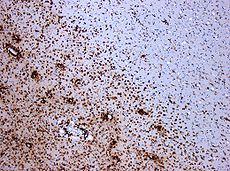- Demyelinating disease
-
Demyelinating disease Classification and external resources 
Photomicrograph of a demyelinating MS-Lesion. Immunohistochemical staining for CD68 highlights numerous macrophages (brown). Original magnification 10×.ICD-10 G35-G37, G61.0 ICD-9 340-341, 357.0 MeSH D003711 A demyelinating disease is any disease of the nervous system in which the myelin sheath of neurons is damaged.[1] This impairs the conduction of signals in the affected nerves, causing impairment in sensation, movement, cognition, or other functions depending on which nerves are involved.
The term describes the effect of the disease, rather than its cause; some demyelinating diseases are caused by genetics, some by infectious agents, some by autoimmune reactions, and some by unknown factors. Organophosphates, a class of chemicals which are the active ingredients in commercial insecticides such as sheep dip, weed-killers, and flea treatment preparations for pets, etc., will also demyelinate nerves.
Neuroleptics can cause demyelination.[2]
Demyelinating diseases
Demyelinating diseases of the central nervous system include:
- multiple sclerosis (together with the similar diseases called idiopathic inflammatory demyelinating diseases)
- Vitamin B12 deficiency
- Central pontine myelinolysis
- Tabes Dorsalis
- transverse myelitis
- Devic's disease
- progressive multifocal leukoencephalopathy
- Optic neuritis
- Leukodystrophies
Demyelinating diseases of the peripheral nervous system include:
- Guillain-Barré syndrome and its chronic counterpart, chronic inflammatory demyelinating polyneuropathy
- anti-MAG peripheral neuropathy
- Charcot-Marie-Tooth Disease
- Copper deficiency
See also
- Multiple sclerosis borderline
- The Lesion Project (multiple sclerosis)
- The Myelin Project
- Myelin Repair Foundation
References
- ^ "demyelinating disease" at Dorland's Medical Dictionary
- ^ Konopaske GT, Dorph-Petersen KA, Sweet RA, et al. (April 2008). "Effect of chronic antipsychotic exposure on astrocyte and oligodendrocyte numbers in macaque monkeys". Biol. Psychiatry 63 (8): 759–65. doi:10.1016/j.biopsych.2007.08.018. PMC 2386415. PMID 17945195. http://linkinghub.elsevier.com/retrieve/pii/S0006-3223(07)00847-5.
Multiple sclerosis and other demyelinating diseases of CNS (G35–G37, 340–341) Signs and symptoms Ataxia · Depression · Diplopia · Dysarthria · Dysphagia · Fatigue · Incontinence · Neurological fatigue · Nystagmus · Optic neuritis · Pain · Uhthoff's phenomenon · Dawson's fingersDiagnosis and evolution following Investigation Treatment Borderline forms Acute disseminated encephalomyelitis · Balo concentric sclerosis · Neuromyelitis optica · Marburg multiple sclerosis · Schilder's disease · Tumefactive multiple sclerosis
(Guillain-Barré syndrome and CIDP are PNS)Other Nervous system pathology, PNS, somatic (G50–G64, 350–357) Nerve, nerve root, plexus V (Trigeminal neuralgia, Anesthesia dolorosa) · VII (Facial nerve paralysis, Bell's palsy, Melkersson–Rosenthal syndrome, Parry–Romberg syndrome, Central seven) · XI (Accessory nerve disorder)Lower limbGeneralPolyneuropathies/Polyradiculoneuropathy Autoimmune/demyelinatingOtherCategories:- Neurological disorders
- Neuroscience stubs
Wikimedia Foundation. 2010.
